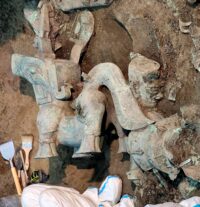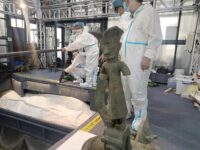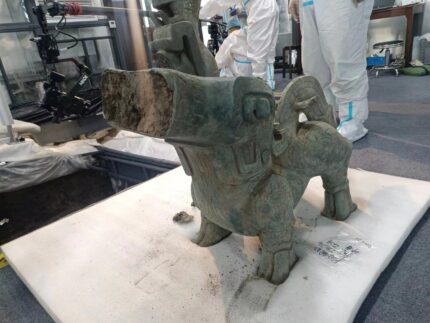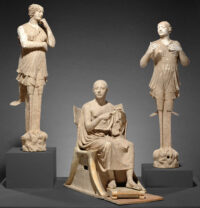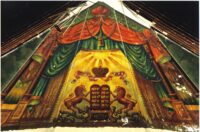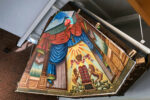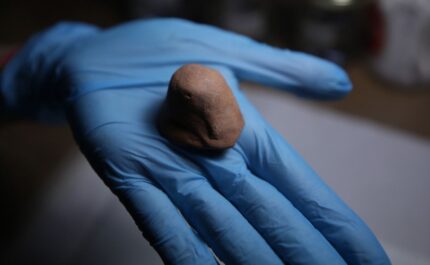 An extremely rare iron folding chair dating to around 600 A.D. has been discovered in the Bavarian region of Middle Franconia. It is only the second folding chair from the early Middle Ages ever found in Germany, and one of fewer than 30 found anywhere in Europe. It is one of only six made of iron.
An extremely rare iron folding chair dating to around 600 A.D. has been discovered in the Bavarian region of Middle Franconia. It is only the second folding chair from the early Middle Ages ever found in Germany, and one of fewer than 30 found anywhere in Europe. It is one of only six made of iron.
Archaeologists unearthed the chair during the course of construction of a business park. It was discovered six and a half feet below the surface in the 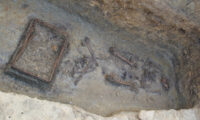 grave of an adult woman. The chair is 28 by 18 inches in its folded position and was deposited at her feet. The bone of an animal (probably the rib of a cow) was next to it. This was likely a meat offering. Remnants of paneling suggest she was laid to rest in a covered wooden chamber with a west-east orientation.
grave of an adult woman. The chair is 28 by 18 inches in its folded position and was deposited at her feet. The bone of an animal (probably the rib of a cow) was next to it. This was likely a meat offering. Remnants of paneling suggest she was laid to rest in a covered wooden chamber with a west-east orientation.
Initial osteological examination indicates she was around 40-50 years old at time of death. She wore a necklace of glass beads and chatelaine on her belt with two bow brooches, a disc brooch, a spindle whorl and a large millefiori glass bead.
 Folding chairs included as grave goods have been interpreted as special indicators not just of social status or wealth, but of political office. The X-shaped chair, the sella curulis, was a potent symbol of rulership and magistracy in ancient Rome, and its association with aristocracy goes back even further to Pharaonic Egypt. Intriguingly, almost all of the 29 early medieval folding chairs found in Europe were discovered in women’s graves.
Folding chairs included as grave goods have been interpreted as special indicators not just of social status or wealth, but of political office. The X-shaped chair, the sella curulis, was a potent symbol of rulership and magistracy in ancient Rome, and its association with aristocracy goes back even further to Pharaonic Egypt. Intriguingly, almost all of the 29 early medieval folding chairs found in Europe were discovered in women’s graves.
A second grave was discovered next to hers in a parallel orientation. This one belonged to an adult male who was buried with a rich array of grave goods as well, including a full set of weapons (lance, shield, spatha sword), a bone comb and a belt with a pouch and a bronze buckle.
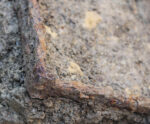 The chair was removed from the grave in a soil block so that it can be excavated in the restoration workshops of the Bavarian State Office for the Preservation of Monuments near Bamberg. It will be X-rayed to give archaeologists an excavation roadmap and to reveal the chair’s condition before it is fully exposed to the air.
The chair was removed from the grave in a soil block so that it can be excavated in the restoration workshops of the Bavarian State Office for the Preservation of Monuments near Bamberg. It will be X-rayed to give archaeologists an excavation roadmap and to reveal the chair’s condition before it is fully exposed to the air.
